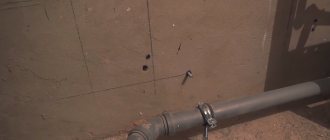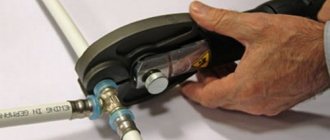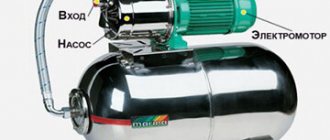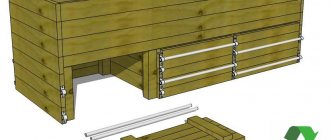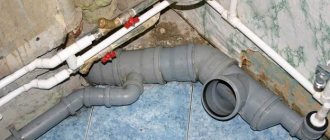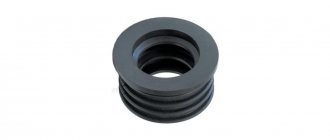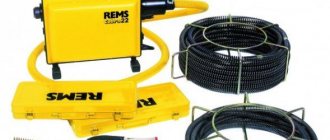The siphon is an integral component of the pipeline. This is one of the modifications of the water seal. The function of the element is to prevent large particles from entering the sewer system and to prevent the back movement of unpleasant odors from the system into the room. The curved shape of the part does not interfere with the movement of wastewater, but retains cleaning and other debris in the lower part.
Food waste, grease, and other foreign objects often cause clogged pipes in the kitchen and bathroom. To eliminate the problem, flushing with chemicals or mechanical methods of removing debris is used. The optimal solution depends on the degree and source of contamination and the design of the siphon.
To reduce the likelihood of a blockage, do not allow food waste, debris, or dirt to enter the drain. As preventive measures, it is recommended to regularly flush the pipeline with hot water, a special chemical solution or traditional methods. This will avoid frequent blockages and extend the life of the plumbing system.
But if contamination does occur, the siphon will need to be cleaned. You can do it yourself or seek help from a qualified technician. In this article we will look at different options for restoring the functionality of the pipeline in the kitchen and bathroom.
Method one: plunger
A plunger is a hand-held rubber device designed for cleaning drains. During pressing, pressure is generated, which loosens the clots of waste and pushes them into the drainage.
The algorithm for cleaning with a plunger is as follows:
- Close the drain with a plug;
- Fill the sink halfway with warm water;
- Cover the drain with a plunger;
- Press the plunger sharply several times;
- When the suction ends, quickly remove the plunger from the drain.
This cleaning option is only possible for minor blockages.
How to prevent blockages from forming?
Blockages in the siphon of a sink or bathtub are an unpleasant occurrence. Despite the fact that you can remove the garbage plug yourself, it is still better not to bring the equipment to this state. ordinary grill installed on the drain hole will become a barrier to blockages. This small accessory captures most of the waste and is very effective at preventing drain clogging. It is advisable to carry out cleaning weekly by rinsing the drain with a stream of hot water, and once or twice a month you need to clean the drain with soda and vinegar. All these procedures do not take time and do not require material costs, but will contribute to the durability of your equipment.
Method two: chemicals
Before cleaning the siphon using a chemical, you need to find out what material the pipes are made of. “Mole” products are suitable for metal pipes; products like “Mr. Muscle” are suitable for any other material.
To clean the sink siphon with a chemical, you must:
- Pour the product into the sink and let it sit for half an hour;
- Fill the sink with warm water;
- Clean with a plunger.
Chemicals remove both blockages and unpleasant odors.
How to remove a sink
First of all, turn off the hot and cold water valves. Turn on the mixer and drain the remaining water. Make sure there is no water left. We take a bucket so as not to make puddles, climb under the sink, and place it under the siphon. Having unscrewed the siphon glass, pour the water into a bucket and screw the glass back on, plugging it with a rag.
Now you need to disconnect the sink from the sewer. We unscrew the nut located under the bottom of the sink counterclockwise, while holding the siphon glass.
Next, disconnect the drain pipe from the siphon by unscrewing the nut at the top of the siphon. Then remove the wedge-shaped washer, nuts on both sides of the drain pipe and remove the pipe itself.
The next step is to remove the siphon from the sewer socket. The connection can be cemented, as in the case of a toilet. So we need to carefully remove this cement
We took a chisel and a hammer and carefully removed it in a circle. Then we carefully remove the siphon from the sewer hole, and plug the hole itself with a rag so that nothing spills out of this sewer towards us.
All difficulties are behind us. Now unscrew the nut under the mixer, disconnect it from the hot and cold water, and remove it from the sink.
And now you can remove the sink. To do this, you need to unscrew the fastening, holding the sink so that it does not fall, or simply remove it from the stand, if there is one.
For subsequent installation, you need to prepare the sewer socket as follows: completely clean off the cement with a hammer and chisel, sand the surface, and wipe with a rag. Now it's ready.
Method three: soda, vinegar, water
An alternative to a chemical product is a mixture of soda and vinegar essence. It happens that the drain does not allow soda to pass through, then you have to push it through with a cotton swab. Cleaning work should be carried out in several stages:
- Wipe the sink with a dry cloth;
- Pour half a glass of soda and the same amount of vinegar into the siphon;
- Cover the drain with a towel for 30-40 minutes;
- Heat water in a kettle and pour it into the siphon. You can use regular tap water.
The described method is suitable for both removal of contamination and prevention.
How to clean a plumbing siphon
If you have read an article about how to clear blockages in a sewer pipe, then you know all the methods, but in relation to water seals, I strongly recommend using only one method, partial disassembly.
The fact is that the plumbing siphon, in addition to its main purpose, preventing the passage of sewer odors into the apartment, has another functional feature that is often forgotten. It works as a filter for heavy and bulky contaminants. They simply precipitate or get stuck in the pipes of the device.
Instead of trying to push the clog into the sewer pipe, in which it will probably get stuck at one of the outlets, it is easier and more convenient to remove it from the sump. Believe me, spending five minutes is not commensurate with the possible problems that will certainly arise if the blockage ends up in the pipe.
Method four: soda, salt, water
Another way is to use three components at once for washing. When water, salt and soda interact, a chemical reaction occurs to form a solution that has cleansing properties.
Algorithm:
- Mix half a glass of soda and the same amount of salt. Pour the resulting mass into the siphon;
- Pour boiling water into the drain;
- Wait for the reaction to complete. Do not use the sink for eight hours;
- After the expiration date, rinse the sink with warm water.
It will be interesting: Comparative review of electric and gas water heaters
The most convenient time to perform the procedure is at night.
Method six: disassembling and washing the siphon
Sometimes neither a plunger, nor a special product, nor even a plumbing cable can remove blockages. In this case, you have to solve the problem yourself by removing the siphon:
- The liquid remains in the siphon after it is removed. To prevent water from spilling, you need to tilt the siphon to the side and wait until it pours out;
- The siphon has two pipes. In order to disconnect it from the sink device, you need to unscrew the nut located on top of the pipe. After this, the siphon will be disconnected;
- Unscrew the bottom of the siphon;
- Wash all parts of the device, check for debris and fat accumulations;
- Reinstall the siphon, checking for leaks during assembly. If there are any, the nuts need to be tightened.
Problems also arise with clean devices. The point is due to incorrect installation, namely, the fitting of the pipe into the glass is too deep: the liquid does not pass due to the small well.
Why clean the siphon?
Many people believe (and I thought so too) that the curved pipe under the sink exists to make life difficult for people. If it weren’t for her, there wouldn’t be a lot of problems associated with a clogged sink.
In fact, the siphon has two functions:
- Firstly, this is a water seal. It acts as a barrier between the central sewer system and the kitchen, preventing unpleasant odors from leaking into the room. It works like this: after using the sink, part of the water goes through the pipes, and part remains in the siphon cup, forming a kind of plug. Over time (for example, when residents are away for a long time), this water evaporates - and after returning, the apartment owners may notice a stench coming from the sink.
- Secondly, it is a garbage catcher. If there were no siphon under the sink, all large objects that accidentally fell into the drain hole or were thrown there on purpose would pass further and form a blockage no longer in an easily accessible place, but somewhere where it is impossible to reach without a specialized tool and significant financial costs. . This would make both the use and maintenance of sewer networks difficult.
Based on the above, it turns out that cleaning the siphon is necessary to maintain hygiene (if it contains not clean water, but rotting food debris, the sink will become a source of bad odor), as well as to maintain the functionality of the drainage system.
Method seven: removing the sump
The problem of blockage is solved by removing the siphon sump. A septic tank is a place where garbage accumulates. This method takes much less time than the previous one, but does not become ineffective.
Procedure:
- Prepare a bucket and place it under the still assembled siphon;
- Unscrew the sump;
- Remove all debris from it and clean the walls from grease stains;
- Screw on the sump;
- Turn on the water and check how easily it flows;
- Once again, pay attention to the sump: if installed incorrectly, leaks are likely.
If the problem is not solved and the water still flows with difficulty, you need to completely disassemble the siphon.
May be interesting: What you need to know when choosing a kitchen sink
Types of siphons according to operating principle
Based on the principle of operation, there are manual, semi-automatic and automatic siphons. Let's take a closer look at each type:
- Manual siphons are characterized by simplicity of design. They consist of a thin chain or flexible cable. A lid is attached to them, which serves as a lock for the drain hole. When you need to drain the water, you just need to pull the chain, after which the lid will rise and release the drain. This system is very cheap and easy to use, but can cause some inconvenience in operation. In particular, not everyone likes to get their hands wet while uncorking the drain;
- Semi-automatic siphons consist of a more complex mechanism: a movable handle and a locking cap. The handle is connected to the lid using a flexible hidden cable. When you want to drain the water, just turn the handle, it will move the lid and the drain hole will open. When drawing water, you also need to turn the handle and plug the drain. The principle of operation allows you not to get your hands wet in water again. A siphon with such an overflow (water drainage) costs a little more than a manual one, but is considered more convenient to use;
- The automatic siphon has no competitors in terms of comfort. There are two types of this design: click-clack and with a handle. Such systems consist of a special control mechanism, a cable, a locking element and a handle. A click-clack machine consists of a flat cover connected to a cable. When pressed, it changes its position. For example, if you press twice, the shutter will open, if once, the lid will close the drain hole. The device with a handle completely replicates the design of the semi-automatic device, but is equipped with an additional protection system.
The main advantage of an automatic siphon is its “smart” operating principle. The automation can be configured so that when the pressure in the bathroom reaches a certain level, the drain hole opens and excess water flows into the sewer. This protects against flooding and problems with horizontal overflow (which, due to its diameter, often cannot handle large amounts of water). For example, click-clack siphons are also capable of closing “on their own” after the pressure reaches the permissible limit.
Method eight: hydraulic pump
Not long ago, a product appeared on the sales market that solves all problems with blockages - a hydraulic pump. This type of device allows you to clean the kitchen and remove blockages in the bathroom. Using a hydraulic pump, a powerful stream of water is generated that pushes debris through. The principle of clearing congestion using a hydraulic pump:
- Clamp the drain hole with a rag;
- Fill the pump with water;
- Press the nozzle onto the drain hole;
- Make 2-3 clicks.
The hydraulic pump is rightfully considered the most effective means of solving the problem of blockages.
Clearing the blockage
Siphon cleaning can be done mechanically or chemically.
Mechanical, in turn, can be done using the following methods:
- With complete or partial disassembly of the siphon;
- Using a plunger;
- With the use of a hydraulic pump;
- Using a cable.
Partial disassembly
This method is available for bottle siphons; it does not imply complete dismantling of the latter. A bucket is installed under the sink or sink into which water and waste will drain. The sump is unscrewed, the cause of the blockage is eliminated, and the part is installed back. When installing, pay attention to the correct installation of all gaskets, otherwise leaks may occur. Cleaning the siphon of washbasins and sinks usually just comes down to a partial disassembly procedure.
Complete disassembly
Cleaning a bathroom siphon usually involves completely disassembling the siphon. Before starting the procedure, place a container into which the water from the system will be drained. Siphons may differ in design, however, in general, the procedure boils down to the following:
- The nut on the knee is unscrewed and it is removed;
- The nut connecting the siphon to the corrugation is removed;
- We dismantle the connection pipe to the washbasin (sink);
- After mechanical cleaning, we wash all parts. The siphon reservoir with outlet must be completely disassembled and cleaned using a piece of cable;
- That's it, you can assemble the siphon in reverse order. Be sure to check the nuts for proper fit and tightness. We let the water run and check for leaks.
Cleaning with a plunger
A plunger is a simple product consisting of a rubber valve and a handle. To begin with, the sink must be filled with water to a level of five to seven centimeters. We press the valve of the plunger to the drain hole, without lifting it from the surface, we make several vigorous movements up and down, as if pushing water into the drain. Remove the plunger and check if the water has started to drain. If not, repeat the procedure. Usually five or six approaches are enough. When cleaning, it is necessary to take into account the presence of an overflow, which should be closed with a stopper or rag to create a vacuum when working with a plunger.
Using a manual hydraulic pump
A manual hydraulic pump is a more modern tool for dealing with blockages. The principle of its operation is quite simple: a water flow is created that pushes the obstacle down the pipe. If this fails, the tool, on the contrary, can direct the flow upward, creating a suction effect on the blockage.
The technology for using a hydraulic pump is quite simple:
- The overflow hole closes;
- A certain amount of water is drawn into the pump (depending on the model);
- The nozzle of the tool is pressed against the drain;
- The trigger is pressed and water is pumped;
- The procedure must be repeated until the blockage is cleared.
Cleaning with a plumbing cable
A plumbing cable is a more difficult tool to use. It is a twisted wire, the length of the cable is usually three meters, but the diameter can vary, depending on the purpose. There is a drill at one end and a handle at the other. The cable is used to remove blockages directly from the water supply system, and not from the siphon itself.
The procedure for removing blockages using such a tool includes the following steps:
- Cover the floor, and preferably the walls, with oilcloth;
- Disassemble and wash the siphon;
- Two people should work with the cable; one person will push the cable and the other will turn it. The cable should be pushed until it fits freely into the pipe, and it must be constantly turned. If progress slows down, it means you are approaching a mud plug. Try to advance the cable, turning it all the time. If forward movement is not possible, do several back-and-forth moves.
- If unsuccessful, remove the tool, clean it and repeat again. It may take up to three or four attempts.
- After the plug is removed, reassemble the siphon and pour a couple of liters of boiling water into the system, this will help drain the remaining dirt.
Removing blockages using chemicals
Today, manufacturers offer a number of ready-made products to remove blockages. Their range is quite large, however, they all act either on the basis of acids or alkalis. When choosing a product, carefully read the instructions for it and follow it exactly. Do not exceed the specified concentration and under no circumstances use two products (especially if we are talking about acidic and alkaline) at the same time, this can lead to damage to the pipes and overall failure of the drainage system.
You can also use a home remedy consisting of non-carbonated soda and table vinegar. True, this mixture only helps with mild blockages. Pour two tablespoons of soda into the drain hole (note that it must be pushed in), then pour in about 200 ml of vinegar. We are waiting for the reaction to end. After a couple of minutes, add two more liters of boiling water.
other methods
A variation of baking soda and a chemical agent is regular hot water. This method is only effective if there is a metal pipeline. Boiling water removes holes in a few minutes. If the pipes are made of plastic, the water is heated, but not extremely hot.
Action plan:
- Prepare a solution: for five liters of liquid there is a glass of powder;
- Pour the solution into the pipeline;
- After 30-40 minutes, treat the drain with water;
- If the blockages have not disappeared, repeat the operation.
If there are not too many blockages, just unscrew the siphon and rinse it thoroughly. The process will take a couple of minutes, but will save you unnecessary problems.
Professional siphon cleaning
If the blockage has formed in an area located further than the water seal, or you have discovered a leak between the elements, all methods for eliminating the problem yourself have already been tried, then you cannot do without the help of a qualified plumber. Professional siphon cleaning is the choice of clients who want to get maximum results and permanently eliminate the possibility of re-contamination of pipes.
I am ready to offer my services to remove blockages. To fix the problem, specialists use modern equipment and special tools. A preliminary study of the system and analysis of the degree of contamination allows you to select the most optimal flushing method and a suitable nozzle for removing debris that caused the blockage.
Stagnation protection
Stagnation occurs due to the negligence of people who let hair, wool, paper, etc. into sewer drains. Siphon needs regular maintenance. In order not to have to worry about cleaning the siphon under the sink, it is enough to periodically pour diluted chemicals into the drain or use a plunger.
It is impossible to completely protect against clogging. However, by performing the operations described above every few months (as well as cleaning the shower stall), the risk of stagnation is minimized.
Currently reading
- Let's talk about high-quality drainage in the form of a shower siphon
- Characteristics and instructions of a bottle siphon for a washbasin
- Features and disadvantages of corrugated siphon
- Everything about choosing a chrome siphon for a sink
Design
Before you get interested in how to remove a siphon from a shower stall, let’s get acquainted with its features. This element is also called a “ladder”. This product can be used to connect various plumbing fixtures. It is not used for structures with a built-in water lock and those that are connected directly to the sewer system. The following elements are suitable for shower trays: 1. Bottle (flask) trays. The functional element here is a special compartment with the shape of a bottle. These siphons are installed for high shower trays. 2. Pipe. They are assembled from several pipes of different lengths, which are connected by adapters. They are characterized by compact dimensions, therefore they are in demand for almost all shower cabins. 3. Corrugated. These are also pipe devices, but instead of hard ones, soft pipes are used that bend easily. They have a rough inner surface, which causes them to become clogged faster, which is why they are less popular. The best option for a shower stall is a pipe siphon, which has suitable characteristics and small dimensions.
Drain design
How to choose the right siphon for a shower stall?
